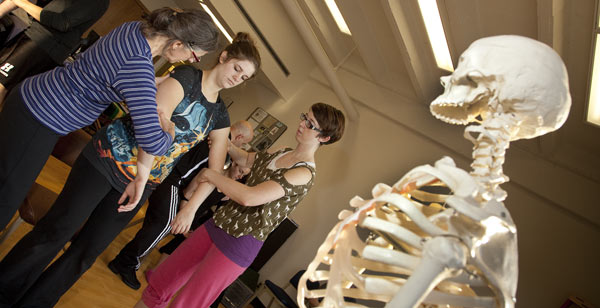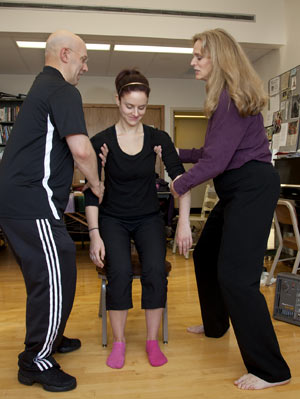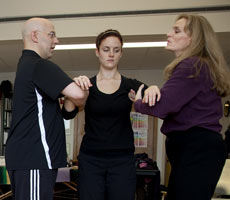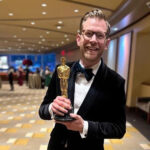
Do you dip your head when pushing up your glasses? Stoop while brushing your teeth? Slouch when grabbing the phone?
The 100-year-old Alexander Technique helps you become more aware of psycho-physical habits that can waste energy in everyday activities. Increasing awareness, theoretically, can help you learn how to retrain your body to move more naturally and efficiently.

But how does that newfound awareness affect the brain? That’s one of the questions being explored by Luc Vanier, associate professor of dance in the Peck School of the Arts, and Wendy Huddleston, assistant professor of kinesiology in the College of Health Sciences. The pair are collaborating on a project titled “Intention and Attention: Transmodernism and Integration in Human Movement Studies,” which is funded by a $50,000 Center for 21st Century Studies Transdisciplinary Challenge Award.
The two-year project has the potential to “revolutionize how dancers understand performance and would redirect how physical therapists would consider their thoughts on activity while working with patients,” the researchers wrote in their grant application.
“A lot of research on this method has looked at efficacy — do you fall less after using the Alexander Technique,” Huddleston says. “We’re looking at the neurophysiology, and I think that’s our niche.”
First developed by F.M. Alexander in Australia in the 1890s, the method is often used by actors, dancers and others in the arts. Vanier, co-author of the book “Dance and the Alexander Technique: Exploring the Missing Link,” first discovered the method in 1994, after a crushed disk and chronic back pain halted his work as a principal ballet dancer. He became so intrigued with the method that he started the three-year, 1,600-hour process of becoming a certified Alexander Technique teacher.
When Vanier later joined the Peck School of the Arts, he hoped to connect with a basic scientist engaged in the fields of attention and neurophysiology; a colleague introduced him to Huddleston. Huddleston, who directs the Visuomotor Laboratory in the Department of Kinesiology, has long been fascinated by the cortical activity underlying intentional movement. She and Vanier started talking and immediately clicked.
People tend to see dance as a series of steps, and physical therapy as a series of exercises. But both disciplines could benefit from a more holistic approach, the researchers say.
“[With the Alexander Technique], it never matters what we do, it always matters how we direct attention,” Vanier says. “So that connection for us is at the crux of what’s possible and what I think is very exciting.”
Awareness first, movement second
So how does the Alexander Technique work? Huddleston, who took Vanier’s class on the method, describes it as very different from traditional PT because it focuses on awareness instead of specific exercises or stretches. Sometimes you might not even realize that your muscles are working against your desired movement, instead of working together smoothly and efficiently.
“Someone who is somewhat fighting themselves may feel that they’re standing upright, but through some awareness and some Alexander work you might realize that you’re not,” she says. “Even things as simple as getting off a chair, or getting on and off the floor — if you’re fighting yourself, you might land on the floor hard, whereas if you’re working more efficiently, the movement might be a different quality.”
One of their first tasks is establishing a common vocabulary. In the spring, the researchers will use functional magnetic resonance imaging (fMRI) to examine cortical activity in people trained in the method and those unfamiliar with it. The control group will be retested six months later after Alexander training.
They’re both excited to see what the fMRI work will reveal. “If someone is moving with more efficiency or fewer bad habits, is that represented cortically, and how does the brain adapt to a more fluid movement?” Huddleston asks.
While the initial fMRI study will focus on dancers and actors at UWM, they plan to use their pilot data to apply for National Institutes of Health funding so they can eventually expand the fMRI study to include other populations.
Next year they will also focus on education around the Alexander Technique, including a mini-symposium. PT and dance students will work together to observe movement from different perspectives, and Vanier and Huddleston will cross-teach in each other’s classes.
The interdisciplinary educational approach will be an asset to doctor of physical therapy and MFA and BFA dance students, the researchers say. Ultimately, they hope the results find their way into dance studios and clinics around the world.
Says Huddleston, “It’s one of the few collaborations where it really feels like there’s a lot to gain on both sides.”







